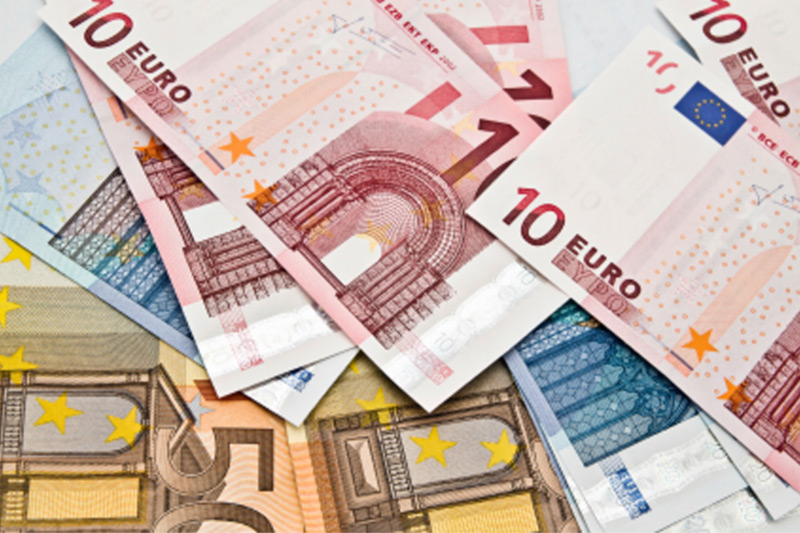Investing.com - The euro was lower against the U.S. dollar and the pound on Thursday, after an auction of Spanish government debt saw the country’s borrowing costs spike, while investors awaited the outcome of a European Central Bank meeting later in the day.
During European late morning trade, the euro was down against the U.S. dollar, with EUR/USD shedding 0.21% to hit 1.3129.
Spain sold the full target amount of EUR2.5 billion of government bonds in its first debt sale since being downgraded by Standard & Poor’s, but the yield on the country’s five-year bonds rose to 4.96% from 3.69%, while the yield on three-year bonds climbed to 4.03% from 2.61%.
Market participants were looking ahead to the outcome of the ECB’s policy meeting, amid pressure on policymakers to resume the bank’s bond purchase program in order to ease pressure on the borrowing costs of vulnerable peripheral euro zone economies.
Elsewhere, Wednesday’s disappointing U.S. private sector employment data fanned fears that the economic recovery is losing momentum, ahead of a government report on nonfarm payrolls on Friday, after government data in March showed a slowdown in hiring.
The single currency was hovering close to a 22-month low against the pound, with EUR/GBP slipping 0.07% to hit 0.8116.
In the U.K., a report showed that service sector activity expanded at a slower rate than expected in April, falling to the lowest level since November, but the report indicated that the overall outlook remained positive.
The services purchasing managers index fell to 53.3 in April, from 55.3 the previous month, worse than expectations for a decline to 54.6.
The euro was little changed against the yen and the Swiss franc, with EUR/JPY inching up 0.06% to hit 105.52 and EUR/CHF dipping 0.01% to hit 1.2013.
The shared currency was mixed against the Canadian, Australian and New Zealand dollars, with EUR/CAD down 0.51% to hit 1.2911, EUR/AUD gaining 0.18% to hit 1.2756 and EUR/NZD jumping 0.71% to hit 1.6344.
The New Zealand dollar weakened broadly after official data showed that the country’s unemployment rate rose unexpectedly in the first quarter, climbing to 6.7%, against expectations for a decline to 6.3%.
Later Thursday, the U.S. was to produce government data on unemployment claims, as well as preliminary data on nonfarm productivity and unit labor costs. In addition, the Institute of Supply Management was to produce a report on service sector growth.
During European late morning trade, the euro was down against the U.S. dollar, with EUR/USD shedding 0.21% to hit 1.3129.
Spain sold the full target amount of EUR2.5 billion of government bonds in its first debt sale since being downgraded by Standard & Poor’s, but the yield on the country’s five-year bonds rose to 4.96% from 3.69%, while the yield on three-year bonds climbed to 4.03% from 2.61%.
Market participants were looking ahead to the outcome of the ECB’s policy meeting, amid pressure on policymakers to resume the bank’s bond purchase program in order to ease pressure on the borrowing costs of vulnerable peripheral euro zone economies.
Elsewhere, Wednesday’s disappointing U.S. private sector employment data fanned fears that the economic recovery is losing momentum, ahead of a government report on nonfarm payrolls on Friday, after government data in March showed a slowdown in hiring.
The single currency was hovering close to a 22-month low against the pound, with EUR/GBP slipping 0.07% to hit 0.8116.
In the U.K., a report showed that service sector activity expanded at a slower rate than expected in April, falling to the lowest level since November, but the report indicated that the overall outlook remained positive.
The services purchasing managers index fell to 53.3 in April, from 55.3 the previous month, worse than expectations for a decline to 54.6.
The euro was little changed against the yen and the Swiss franc, with EUR/JPY inching up 0.06% to hit 105.52 and EUR/CHF dipping 0.01% to hit 1.2013.
The shared currency was mixed against the Canadian, Australian and New Zealand dollars, with EUR/CAD down 0.51% to hit 1.2911, EUR/AUD gaining 0.18% to hit 1.2756 and EUR/NZD jumping 0.71% to hit 1.6344.
The New Zealand dollar weakened broadly after official data showed that the country’s unemployment rate rose unexpectedly in the first quarter, climbing to 6.7%, against expectations for a decline to 6.3%.
Later Thursday, the U.S. was to produce government data on unemployment claims, as well as preliminary data on nonfarm productivity and unit labor costs. In addition, the Institute of Supply Management was to produce a report on service sector growth.
